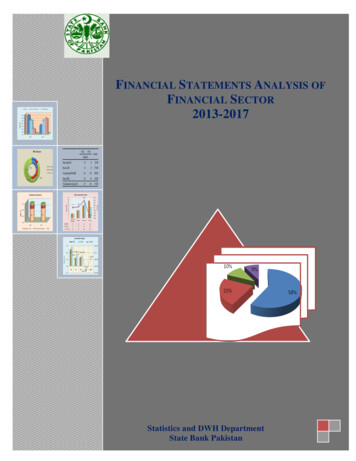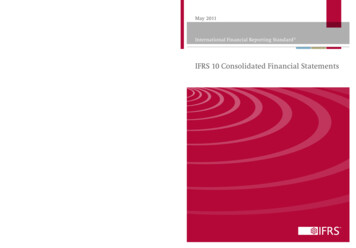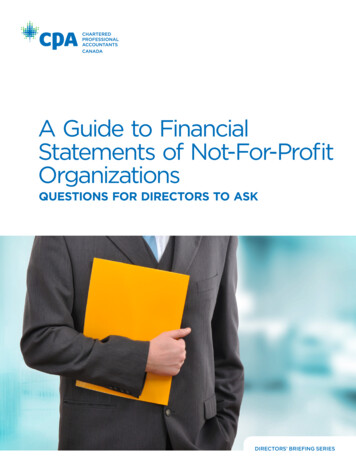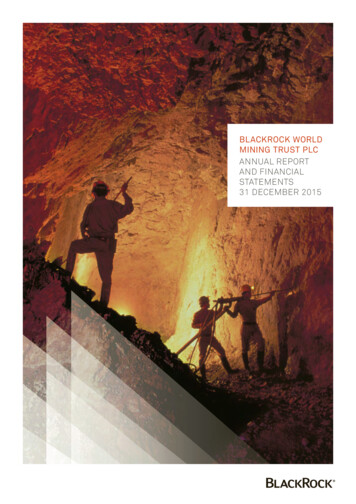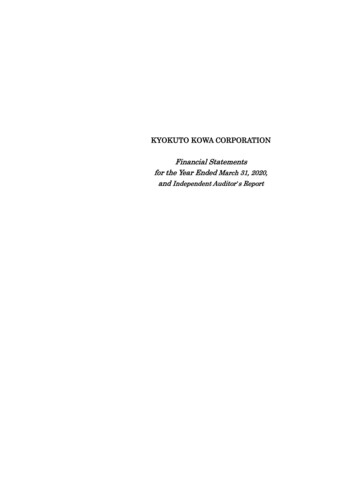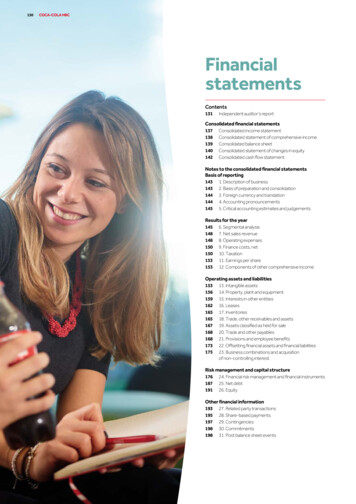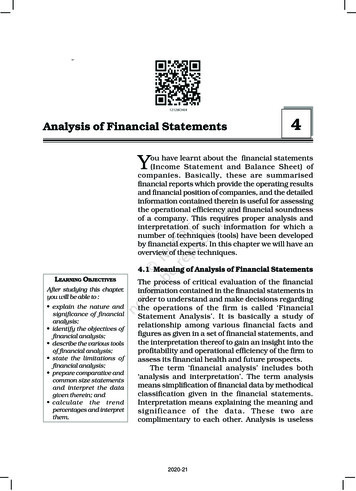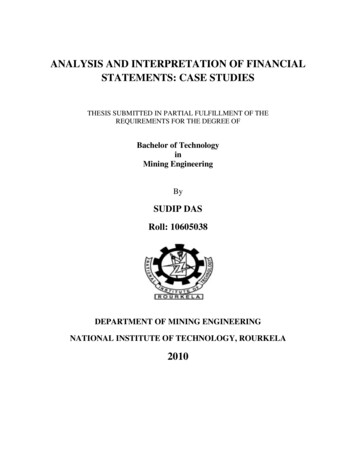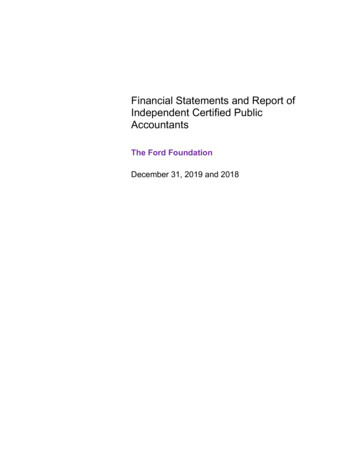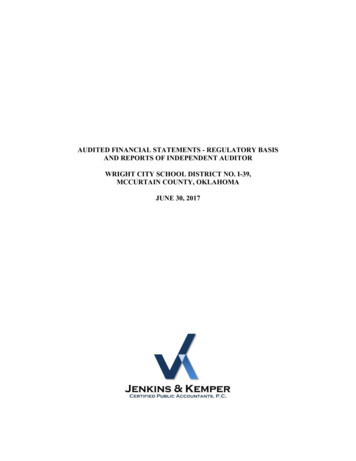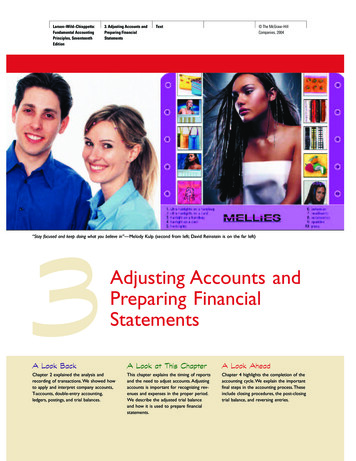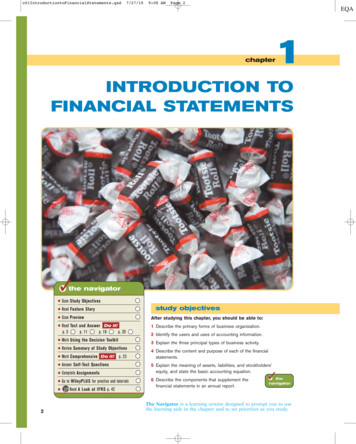
Transcription
8 AMPage 21chapterINTRODUCTION TOFINANCIAL STATEMENTS the navigator Scan Study Objectives Read Feature Story Scan PreviewAfter studying this chapter, you should be able to: Read Text and Answer Do it!p. 5p. 11p. 18p. 201 Describe the primary forms of business organization. Work Using the Decision Toolkit Review Summary of Study Objectives Work Comprehensive Do it! p. 23 Answer Self-Test Questions Complete Assignments Go to WileyPLUS for practice and tutorials 2Read A Look at IFRS p. 42study objectives2 Identify the users and uses of accounting information.3 Explain the three principal types of business activity.4 Describe the content and purpose of each of the financialstatements.5 Explain the meaning of assets, liabilities, and stockholders’equity, and state the basic accounting equation.6 Describe the components that supplement thefinancial statements in an annual report.The Navigator is a learning system designed to prompt you to usethe learning aids in the chapter and to set priorities as you study.
7 AMPage 3feature storyMany students who take this course do not plan to beaccountants. If you are in that group, you might bethinking, “If I’m not going to be an accountant, why doI need to know accounting?” In response, considerthis quote from Harold Geneen, the former chairmanof IT&T: “To be good at your business, you have toknow the numbers—cold.” Success in any businesscomes back to the numbers. You will relyon them to make decisions, and managers will use them to evaluate yourperformance. That is true whether yourjob involves marketing, production,management, or information systems.In business, accounting and financial statementsare the means for communicating the numbers. If youdon’t know how to read financial statements, you can’treally know your business.Many companies spend significant resourcesteaching their employees basic accounting so that theycan read financial statements and understand howtheir actions affect the company’s financial results.One such company is Springfield ReManufacturingCorporation (SRC). When Jack Stack and 11 othermanagers purchased SRC for 10 cents a share, itwas a failing division of International Harvester. Jack’s119 employees were counting on him for their livelihood. He decided that for the company to survive,every employee needed to think like a businesspersonand to act like an owner. To accomplish this, all employees at SRC took basic accounting courses andparticipated in weekly reviews of the company’s financial statements. SRC survived, and eventually thrived.To this day, every employee (now numbering more than1,000) undergoes this same training.Many other companies haveadopted this approach, which iscalled “open-book management.” Even in companiesthat do not practice open-book management, employers generally assume that managers in all areas of thecompany are “financially literate.”Taking this course will go a long way to making youfinancially literate. In this book you will learnhow to read and prepare financial statements, and how to use basic tools to evaluate financial results. In this first chapterwe will introduce you to the financialstatements of a real company whoseproducts you are probably familiar with—Tootsie Roll.Tootsie Roll’s presentation of its financial results is complete, yet also relatively easy to understand.Tootsie Roll started off humbly in 1896 in a smallNew York City candy shop owned by an Austrian immigrant, Leo Hirshfield. The candy’s name came fromhis five-year-old daughter’s nickname—“Tootsie.” Todaythe Chicago-based company produces more than49 million Tootsie Rolls and 16 million Tootsie Popseach day. In fact, Tootsie Pops are at the center of oneof science’s most challenging questions: How manylicks does it take to get to the Tootsie Roll center ofa Tootsie Pop? The answer varies: Licking machinescreated at Purdue University and the University ofMichigan report an average of 364 and 411 licks, respectively. In studies using human lickers, the answerranges from 144 to 252. We recommend that you takea few minutes today away from your studies to determine your own results.KN O W I N G TH ENUMBERSSource: Tootsie Roll information adapted fromwww.tootsie.com.INSIDE CHAPTER 1 . . . The Scoop on Accounting (p. 6)Spinning the Career Wheel (p. 7)The Numbers Behind Not-for-Profit Organizations (p. 8)Rocking the Bottom Line (p. 15)3
9 PMPage 4preview of chapter 1How do you start a business? How do you determine whether your business is making or losing money? Howshould you finance expansion—should you borrow, should you issue stock, should you use your own funds?How do you convince lenders to lend you money or investors to buy your stock? Success in business requiresmaking countless decisions, and decisions require financial information.The purpose of this chapter is to show you what role accounting plays in providing financial information. Thecontent and organization of the chapter are as follows.Introduction to Financial StatementsForms of BusinessOrganization Sole proprietorship Partnership CorporationUsers and Uses ofFinancial Information Internal users External users Ethics in financial reportingCommunicatingwith UsersBusiness Activities Financing Investing Operating Income statementRetained earnings statementBalance sheetStatement of cash flowsInterrelationships ofstatements Other elements of an annualreportForms of Business Organizationstudy objective1Describe the primary formsof business organization.Sole Proprietorship-Simple to establish-Owner controlled-Tax advantagesPartnership-Simple to establish-Shared control-Broader skills and resources-Tax advantagesCorporation-Easier to transfer ownership-Easier to raise funds-No personal liability4Suppose you graduate with a business degree and decide you want to start yourown business. But what kind of business? You know that you enjoy working withpeople, especially teaching them new skills. And, ever since you were young, youhave spent most of your free time outdoors, kayaking, backpacking, skiing, rockclimbing, and mountain biking. You therefore realize that you might be most successful in opening an outdoor guide service where you grew up, in the SierraNevada mountains.Your next decision is to determine what organizational form your business willhave. You have three choices—sole proprietorship, partnership, or corporation.You might choose the sole proprietorship form for your outdoor guide service.A business owned by one person is a sole proprietorship. It is simple to set upand gives you control over the business. Small owner-operated businesses such asbarber shops, law offices, and auto repair shops are often sole proprietorships, asare farms and small retail stores.Another possibility is for you to join forces with other individuals to form apartnership. A business owned by two or more persons associated as partnersis a partnership. Partnerships often are formed because one individual does nothave enough economic resources to initiate or expand the business. Sometimes, partners bring unique skills or resources to the partnership. You andyour partners should formalize your duties and contributions in a written partnership agreement. Retail and service-type businesses, including professionalpractices (lawyers, doctors, architects, and certified public accountants), oftenorganize as partnerships.As a third alternative, you might organize as a corporation. A business organized as a separate legal entity owned by stockholders is a corporation. Investors in a corporation receive shares of stock to indicate their ownership claim.Buying stock in a corporation is often more attractive than investing in a partnership because shares of stock are easy to sell (transfer ownership). Selling aproprietorship or partnership interest is much more involved. Also, individuals
9 PMPage 55Users and Uses of Financial Informationcan become stockholders by investing relatively small amounts of money. Therefore, it is easier for corporations to raise funds. Successful corporations often have thousands of stockholders, and their stock is traded on organized stockexchanges like the New York Stock Exchange. Many businesses start as sole proprietorships or partnerships and eventually incorporate. For example, in 1896Leo Hirshfield started Tootsie Roll as a sole proprietorship, and by 1919 the company had incorporated.Other factors to consider in deciding which organizational form to chooseare taxes and legal liability. If you choose a sole proprietorship or partnership,you generally receive more favorable tax treatment than a corporation. However,proprietors and partners are personally liable for all debts of the business; corporate stockholders are not. In other words, corporate stockholders generallypay higher taxes but have no personal liability. We will discuss these issues inmore depth in a later chapter.The combined number of proprietorships and partnerships in the UnitedStates is more than five times the number of corporations. However, the revenueproduced by corporations is eight times greater. Most of the largest enterprisesin the United States—for example, Coca-Cola, ExxonMobil, General Motors,Citigroup, and Microsoft—are corporations. Because the majority of U.S. business is transacted by corporations, the emphasis in this book is on the corporate form of organization.Alternative TerminologyStockholders are sometimes calledshareholders.Alternative Terminologynotes present synonymousterms that you may comeacross in practice.before you go on.Do it!In choosing the organizational form for your outdoor guide service, youshould consider the pros and cons of each. Identify each of the following organizationalcharacteristics with the organizational form or forms with which it is associated.BUSINESSORGANIZATION FORMS1.2.3.4.5.Do it! exercises promptyou to stop and reviewthe key points you havejust studied.Easier to raise fundsSimple to establishNo personal legal liabilityTax advantagesEasier to transfer ownershipSolution1.2.3.4.5.Easier to raise funds: Corporation.Simple to establish: Sole proprietorship and partnership.No personal legal liability: Corporation.Tax advantages: Sole proprietorship and partnership.Easier to transfer ownership: Corporation.Action Plan Know which organizational formbest matches the business type,size, and preferences of theowner(s).Action Plans give youtips about how toapproach the problem.Related exercise material: BE1-1 and Do it! 1-1.Users and Uses of Financial InformationThe purpose of financial information is to provide inputs for decision making.Accounting is the information system that identifies, records, and communicatesthe economic events of an organization to interested users. Users of accounting information can be divided broadly into two groups: internal users and external users.INTERNAL USERSInternal users of accounting information are managers who plan, organize, andrun a business. These include marketing managers, production supervisors,finance directors, and company officers. In running a business, managersmust answer many important questions, as shown in Illustration 1-1 (page 6).study objective2Identify the users and usesof accounting information.
09 PMPage 6chapter 1 Introduction to Financial StatementsQuestions Asked by Internal UsersSTSTRIKEONRIKErfai esUn cticaPrplaylistitunesL. H.C.B.Brien'sInSgt. Pepper'sComesMy ShipCowboy?WhenDo WiaGonnaWhatis A LifeWantAll IMENUSnackackckk gStockholderFinanceIs cash sufficient to paydividends toMicrosoft stockholders?Illustration 1-1Questions that internalusers askIllustrations like thisone convey informationin pictorial form to helpyou visualize and applythe ideas as you study.MarketingWhat price for an Apple iPodwill maximize the company'snet income?Human ResourcesCan we afford to giveGeneral Motors employeespay raises this year?ManagementWhich PepsiCo product line isthe most profitable? Should anyproduct lines be eliminated?To answer these and other questions, you need detailed information on a timelybasis. For internal users, accounting provides internal reports, such as financialcomparisons of operating alternatives, projections of income from new sales campaigns, and forecasts of cash needs for the next year. In addition, companies present summarized financial information in the form of financial statements.Accounting Across the OrganizationThe Scoop on AccountingAccounting can serve as a useful recruiting tool even for the human resourcesdepartment. Rhino Foods, located in Burlington, Vermont, is a manufacturer of specialtyice cream. Its corporate website includes the following:“Wouldn’t it be great to work where you were part of a team? Where your input andhard work made a difference? Where you weren’t kept in the dark about what management was thinking? . . . Well—it’s not a dream! It’s the way we do business . . .Rhino Foods believes in family, honesty and open communication—we really care aboutand appreciate our employees—and it shows. Operating results are posted andmonthly group meetings inform all employees about what’s happening in the Company.Employees also share in the Company’s profits, in addition to having an excellentcomprehensive benefits package.”Source: ting Across theOrganization storiesshow applications ofaccounting informationin various businessfunctions.Illustration 1-2Questions that externalusers ask?What are the benefits to the company and to the employees of making the financial statements available to all employees? (See page 41.)EXTERNAL USERSThere are several types of external users of accounting information. Investors(owners) use
INTRODUCTION TO FINANCIAL STATEMENTS 1 2 The Navigatoris a learning system designed to prompt you to use the learning aids in the chapter and to set priorities as you study. Scan Study Objectives Read Feature Story Scan Preview Read Text and Answer p. 5 p. 11 p. 18 p. 20 Work Using the Decision Toolkit Review Summary of Study Objectives Work Comprehensive p. 23 Answer Self
